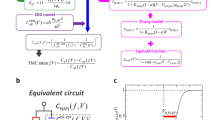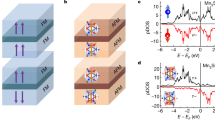Abstract
The electromotive force (e.m.f.) predicted by Faraday’s law reflects the forces acting on the charge, –e, of an electron moving through a device or circuit, and is proportional to the time derivative of the magnetic field. This conventional e.m.f. is usually absent for stationary circuits and static magnetic fields. There are also forces that act on the spin of an electron; it has been recently predicted1,2 that, for circuits that are in part composed of ferromagnetic materials, there arises an e.m.f. of spin origin even for a static magnetic field. This e.m.f. can be attributed to a time-varying magnetization of the host material, such as the motion of magnetic domains in a static magnetic field, and reflects the conversion of magnetic to electrical energy. Here we show that such an e.m.f. can indeed be induced by a static magnetic field in magnetic tunnel junctions containing zinc-blende-structured MnAs quantum nanomagnets. The observed e.m.f. operates on a timescale of approximately 102–103 seconds and results from the conversion of the magnetic energy of the superparamagnetic MnAs nanomagnets into electrical energy when these magnets undergo magnetic quantum tunnelling. As a consequence, a huge magnetoresistance of up to 100,000 per cent is observed for certain bias voltages. Our results strongly support the contention that, in magnetic nanostructures, Faraday’s law of induction must be generalized to account for forces of purely spin origin. The huge magnetoresistance and e.m.f. may find potential applications in high sensitivity magnetic sensors, as well as in new active devices such as ‘spin batteries’.
This is a preview of subscription content, access via your institution
Access options
Subscribe to this journal
Receive 51 print issues and online access
$199.00 per year
only $3.90 per issue
Buy this article
- Purchase on Springer Link
- Instant access to full article PDF
Prices may be subject to local taxes which are calculated during checkout




Similar content being viewed by others
References
Barnes, S. E. & Maekawa, S. Generalization of Faraday’s law to include nonconservative spin forces. Phys. Rev. Lett. 98, 246601 (2007)
Barnes, S. E. Spin motive forces, “measurements”, and spin-valves. J. Magn. Magn. Mater. 310, 2035–2037 (2007)
Fulton, T. A. & Dolan, G. J. Observation of single-electron charging effects in small tunnel junctions. Phys. Rev. Lett. 59, 109–112 (1987)
Sanvito, S. & Hill, A. N. Ground state of half-metallic zinc-blende MnAs. Phys. Rev. B 62, 15553–15560 (2000)
Sato, K., Katayama–Yoshida, H. & Dederichs, P. H. High Curie temperature and nano-scale spinodal decomposition phase in dilute magnetic semiconductors. Jpn. J. Appl. Phys. 44, L948–L951 (2005)
Moreno, M., Trampert, A., Jenichen, B., Daweritz, L. & Ploog, K. H. Correlation of structure and magnetism in GaAs with embedded Mn(Ga)As magnetic nanoclusters. J. Appl. Phys. 92, 4672–4677 (2002)
Yokoyama, M., Yamaguchi, H., Ogawa, T. & Tanaka, M. Zinc-blende-type MnAs nanoclusters embedded in GaAs. J. Appl. Phys. 97, 10D317 (2005)
Kwiatkowski, A. et al. Structure and magnetism of MnAs nanocrystals embedded in GaAs as a function of post-growth annealing temperature. J. Appl. Phys. 101, 113912 (2007)
Binasch, G., Grünberg, P., Saurenbach, F. & Zinn, W. Enhanced magnetoresistance in layered magnetic structures with antiferromagnetic interlayer exchange. Phys. Rev. B 39, 4828–4830 (1989)
Baibich, M. N. et al. Giant magnetoresistance of (001)Fe/(001)Cr magnetic superlattices. Phys. Rev. Lett. 61, 2472–2475 (1988)
Moodera, J. S., Kinder, L. R., Wong, T. M. & Meservey, R. Large magnetoresistance at room temperature in ferromagnetic thin film tunnel junctions. Phys. Rev. Lett. 74, 3273–3276 (1995)
Miyazaki, T. & Tezuka, N. Giant magnetic tunnelling effect in Fe/Al2O3/Fe junction. J. Magn. Magn. Mater. 139, L231–L234 (1995)
Parkin, S. S. P. Giant tunnelling magnetoresistance at room temperature with MgO (100) tunnel barriers. Nature Mater. 3, 862–867 (2004)
Yuasa, S., Nagahama, T., Fukushima, A., Suzuki, Y. & Ando, K. Giant room-temperature magnetoresistance in single-crystal Fe/MgO/Fe magnetic tunnel junctions. Nature Mater. 3, 868–871 (2004)
Jin, S. et al. Thousandfold change in resistivity in magnetoresistive La-Ca-Mn-O films. Science 264, 413–415 (1994)
Tokura, Y. (ed.) Advances in Condensed Matter Science Vol. 2, Colossal Magnetoresistance Oxides (Gordon & Breach, 2000)
Barnes, S. E., Ieda, J. & Maekawa, S. Magnetic memory and current amplification devices using moving domain walls. Appl. Phys. Lett. 89, 122507 (2006)
Barnes, S. E. & Maekawa, S. Currents induced by domain wall motion in thin ferromagnetic wires. Preprint at 〈http://arxiv.org/abs/cond-mat/0410021v1〉 (2004)
Barbara, B. et al. Mesoscopic quantum tunnelling of magnetization. J. Magn. Magn. Mater. 140–144, 1825–1828 (2002)
Tanaka, M. et al. Epitaxial orientation and magnetic properties of MnAs thin films grown on (001) GaAs: Template effects. Appl. Phys. Lett. 65, 1964–1966 (1994)
Tanaka, M. Ferromagnet (MnAs)/III–V semiconductor hybrid structures. Semicond. Sci. Technol. 17, 327–341 (2002)
Acknowledgements
This work was partly supported by Grant-in-Aids for Scientific Research No. 18106007, No. 19048018 and No. 20686002, the Special Coordination Programs for Promoting Science and Technology, and R&D for Next-Generation Information Technology by MEXT, PRESTO of JST, and EPSRC (UK). We thank B.-H. Yu for his help in the transport measurements. P.N.H. acknowledges a JSPS Research Fellowship for Young Scientists and the Global COE Program (CO4).
Author Contributions P.N.H. designed the experiment, fabricated the samples, collected most of data and performed analysis of data; S.O. set up measurement apparatuses and gave experimental advice; M.T. managed and planned the research and supervised the experiment; and S.E.B. and S.M. developed the theoretical explanation of the experiment. All authors discussed the results and commented on the manuscript.
Author information
Authors and Affiliations
Corresponding author
Supplementary information
Supplementary Information
This file contains Supplementary Notes, Supplementary Figures S1-S5 with Legends and Supplementary References (PDF 835 kb)
Rights and permissions
About this article
Cite this article
Hai, P., Ohya, S., Tanaka, M. et al. Electromotive force and huge magnetoresistance in magnetic tunnel junctions. Nature 458, 489–492 (2009). https://doi.org/10.1038/nature07879
Received:
Accepted:
Published:
Issue Date:
DOI: https://doi.org/10.1038/nature07879
This article is cited by
-
Impedance spectroscopy data for 2D biintercalate clathrate InSe<
+ > Applied Nanoscience (2023)
-
Electrical properties of clathrate formed on the basis of a p-type semiconductor with 2D guest positions filled with ferroelectric and propolis
Applied Nanoscience (2022)
-
Record thermopower found in an IrMn-based spintronic stack
Nature Communications (2020)
-
Spin-driven electrical power generation at room temperature
Communications Physics (2019)
-
Room temperature electrically tunable rectification magnetoresistance in Ge-based Schottky devices
Scientific Reports (2016)
Comments
By submitting a comment you agree to abide by our Terms and Community Guidelines. If you find something abusive or that does not comply with our terms or guidelines please flag it as inappropriate.



